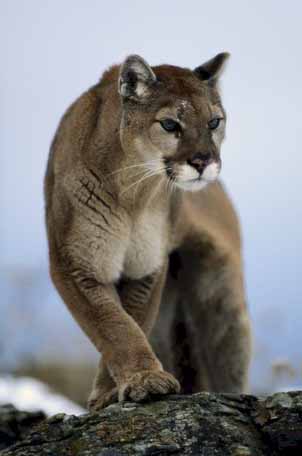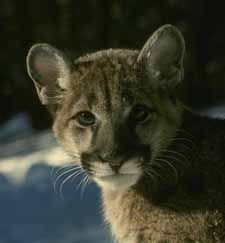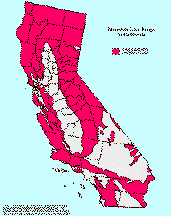Mountain lion
and human interactions in Yosemite National Park
Leslie S. Chow
Research Wildlife Biologist
Yosemite Field Station
U. S. Geological Survey
Update (11/03): Park biologists
had to euthanize two Mountain lions in Yosemite Valley because of possible
danger to visitors. The lions were hunting raccoons
-- themselves attracted by food left by campers -- in heavily used areas. Full
Story.
 |
| The
Mountain Lion, also known as cougar, panther or puma (Felis
concolor). Defenders of Wildlife photo |
A dramatic rise in puma sightings and apparent changes in puma behavior raised concerns about increased risks to visitor safety in Yosemite National Park. We investigated the movements and behavior of radio collared pumas to determine how much time they spent in developed areas and what they were doing while they were there.
Radio telemetry and track transects found that pumas occasionally passed through developed areas but seldom lingered. Information gathered subsequent to our study revealed that pumas occasionally use Yosemite Valley for extended periods of time. Observations of pumas repeatedly chasing and killing raccoons suggest that they may be drawn into developed areas by abundant prey.
Although pumas did not show any interest in humans, repeated exposure to people raises questions about possible habituation and future threats.
Background
In 1994, there was a dramatic increase in the number of reported puma sightings
in Yosemite National Park. The increase in sightings raised concerns because
many occurred in developed areas frequented by thousands of park visitors.
The deaths of two women in other parts of California that year from puma
predation further heightened concerns about potential threats to visitor
safety.
More troubling was the behavior accompanying many of these sightings. In several cases, pumas came within a few meters of people. Although there were no reports of aggressive behavior, we feared the situation put the safety of park visitors and staff at risk.
In trying to understand the increase in reported sightings, we ruled out the often cited explanation of human encroachment into puma habitat because park visitation had not increased significantly. Simply attributing the increase in sightings to higher puma population numbers also failed to explain why pumas suddenly accepted being in close proximity to people.
 |
| Mountain Lion cub. California Department of Fish and Game photo. |
In light of potential conflicts between pumas and people, we initiated a study in 1996 to assess the level of risk associated with pumas frequenting developed areas in Yosemite. To achieve our study objectives we asked the following research questions:
To what extent were pumas using developed areas in Yosemite National Park? We assumed that increased contact between pumas and humans increased the likelihood of conflict. Knowing how often pumas were entering developed areas and how much time they spent there would provide a measure of risk associated with their presence.
What activities were pumas engaged in when using developed areas? Were they simply passing through or were they resident? What kind of animals were using developed areas? Were they adults or dispersing juveniles? Were they males or females? What was their nutritional status?
Study Area
The study area comprised an 1195-km2 area in Yosemite National Park, Stanislaus
and Sierra National Forests, and Mariposa County in the Sierra Nevada of
California
Methods
Pumas were captured using trailing hounds and foot snares.
We collected standard biological data such as age, sex, and nutritional status
and equipped pumas with radio telemetry collars to monitor their movements
and activities.
We established and monitored track and scat transects to detect the presence
of uncollared pumas.
We collected puma feces and used DNA analysis to identify individual animals.
We appealed to park residents and visitors through posters, flyers, and word
of mouth to report their puma sightings.
Results
Six of the seven pumas we captured were female; most of them older adults.
Although we only caught one male, we know at least one more passed through
the study area several times. Female #8 was accompanied by two juveniles
who dispersed before they could be captured. Female #1 gave birth to three
kittens that disappeared two months after they were born. Fecal DNA analysis
revealed the presence of 9 additional pumas in the study area. Unfortunately,
the analysis could not determine their sex.
The 18 known individuals in the study area yield a minimum estimate of 1 puma per 66 square kilometers. The absence of adult males in our sample suggests that actual density is probably higher.
Four of the seven pumas we captured either died or disappeared during the study. One died of natural causes. Another died after colliding with a snow plow. One disappearance probably resulted from poaching while the other was lost to dispersal.
Radio telemetry revealed that some pumas migrated seasonally between higher and lower elevations. Others remained in one area throughout the year. Although the home ranges of adult female pumas overlapped spatially, closer examination revealed that they segregated temporally. Telemetry also revealed that pumas occasionally passed through developed areas but seldom lingered.
 |
| Dog
Tracks (left) vs Mountain Lion Tracks (right) California Department of Fish and Game drawing. |
Track transects showed that pumas often crossed or walked along hiking trails.
Telemetry data, in conjunction with track, scat, and scrape transects, showed that pumas were widely distributed throughout the study area. However, during three years of fieldwork, we never verified the presence of a puma in Yosemite Valley.
Discussion
Sighting data from 1992 through 2001 show annual variation in the number
of puma sightings in Yosemite. Reports accompanying these sightings suggest
this is largely due to the periodic use of Yosemite Valley by pumas rather
than an increase in park visitation or growth of the puma population.
In the three years following the conclusion of this study there were two
separate instances in which an adult female, accompanied by two sub-adult
kittens, established residence in Yosemite Valley for several weeks at a
time. During the summer of 2001, the most recent year this situation occurred,
more than 60 percent of reported sightings involved a puma chasing, killing,
or eating a raccoon. Reports from 1994 also recount instances of pumas killing
raccoons and coyotes in campgrounds and developed areas.
Attracted by visitor handouts and garbage, raccoons, coyotes, and mule
deer regularly frequent Yosemite Valley and other developed areas in the
Park. Consequently, these locations may represent a reliable source of
prey for female pumas faced with feeding their offspring. Raccoons and
coyotes may also be ideal prey for young pumas learning to hunt.
Female puma #8 provides an example of this scenario. In December 1998, her front leg was broken when she collided with a snowplow while crossing the highway with her two yearlings. Telemetry subsequently documented her restricted movements for the remainder of winter. The following spring, she was often seen scavenging road kills along the highway. In June, after dispersing her offspring, she began scouring the housing area in Wawona searching for food. We monitored her behavior for several weeks until she died. A necropsy revealed she starved to death.
Although telemetry found that our radio collared pumas seldom lingered in developed areas, sighting reports and the behavior of female puma #8 indicate this is not always true. It appears that nutritional stress can induce pumas to use developed areas more extensively, especially when coupled with a reliable food source. Whether this apparent behavioral plasticity is limited to certain individuals or indicative of the entire population is unknown.
It is significant that none of the puma sighting reports we examined mentioned any sign of aggressive behavior towards humans. In fact, most reports implied the puma was oblivious to people, despite their proximity; often only meters away. On three occasions, we used radio telemetry to follow and observe pumas at close range. Although they were aware of us, none of these animals exhibited any reaction to our presence. In another case, we were led to an un-collared puma by its calls and tracks. This animal also appeared indifferent to our presence.
 |
| Current
range of Mountain Lions in California (click to enlarge). California Department of Fish and Game photo. |
Management Implications
Based on information gleaned from sighting reports and our observations of
radio collared pumas, we conclude that pumas currently do not perceive
humans as potential prey. This suggests that the mere presence of pumas
in developed areas does not represent an immediate or direct threat to
human safety. However, the risk always exists and is likely to increase
as the frequency of encounters between pumas and humans rises. Thus, we
believe the National Park Service should make efforts to reduce the likelihood
of encounters between pumas and people.
It is well documented that the availability of human food attracts unusually high numbers of black bears to Yosemite Valley. This, in addition to wildlife feeding by park visitors and staff has also drawn raccoons, coyotes, and mule deer into developed areas. We suspect that female pumas, faced with the nutritional demands of feeding offspring, have learned to take advantage of this resource.
We believe educating the public and enforcing regulations prohibiting feeding of animals can reduce the size of prey populations in Yosemite Valley thereby eliminating an attractant to pumas. This in turn should increase visitor safety while protecting Yosemite’s pumas from unnecessary manipulation.
Acknowledgments
This study was generously supported by the Yosemite
Fund and U. S. Geological
Survey. Cooperators included the National
Park Service, the California
Department of Fish and Game, and the USDA-Wildlife
Services.
Further Reading
California Department
of Fish and Game Living
with California Mountain Lions
Hear a Mountain Lion (.wav)
Our Founder Questions? Go to About Our New Site |
Masthead
Photo from: |